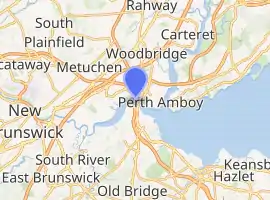Edison Bridge (New Jersey)
The Edison Bridge (officially the Thomas Alva Edison Memorial Bridge) is a bridge on U.S. Route 9 in New Jersey, spanning the Raritan River near its mouth in Raritan Bay. The bridge, which connects Woodbridge on the north with Sayreville on the south, was opened to weekend traffic starting on October 11, 1940, and was opened permanently on November 15, 1940.[1] As of 2003, the bridge carries more than 82,000 vehicles daily and is owned and operated by the New Jersey Department of Transportation. It also runs directly parallel to the Driscoll Bridge.
Edison Bridge | |
|---|---|
 The Driscoll Bridge (left) and the Edison Bridge (right). | |
| Coordinates | 40°30′32″N 74°18′02″W |
| Carries | |
| Crosses | Raritan River |
| Locale | Woodbridge and Sayreville, Middlesex County, New Jersey |
| Official name | Thomas Alva Edison Memorial Bridge |
| Other name(s) | Ellis S. Vieser Memorial Bridge |
| Maintained by | NJDOT |
| Characteristics | |
| Design | Girder |
| Total length | 4,391 feet (1,338 m) |
| No. of spans | 29 |
| History | |
| Construction start | September 26, 1938 |
| Opened | October 11, 1940 |
| Inaugurated | December 14, 1940 |
| Location | |

| |
Construction
The design of the Edison Bridge was the direct responsibility of Morris Goodkind, chief engineer of the bridge division of the New Jersey State Highway Department, a position he had held since 1925.
The bridge is named for Thomas Edison. Construction on the bridge was started on September 26, 1938. The Edison Bridge was officially dedicated on December 14, 1940, with the ribbon cut by Mrs. Mina Edison Hughes, widow of the inventor. Also participating in the ceremonies were New Jersey Governor A. Harry Moore, and then Governor-elect Charles Edison, son of the inventor, along with the bridge's designer, Morris Goodkind.[1]
The final design called for a bridge with 29 spans and an overall length of 4,391 feet (1,338 m). The nine spans over the river would consist of three continuous span girders of record-setting proportions. The main girder over the navigation channel would be 650 feet (200 m) in length, consisting of a 250-foot (76 m) span flanked by two 200-foot (61 m) spans, and would set a new U.S. record for length. The two other continuous girders were each 600 feet (180 m) in length, consisting of three 200-foot (61 m) spans.
The final cost of the bridge was $4,696,000. More than 65,000 cubic yards (50,000 m3) of masonry, 50 percent buried from sight, went into the foundations, piers, and deck of the bridge. Over 2,500,000 pounds (1,133.98 metric tons) of reinforcing steel and 19,000,000 pounds (8,618.26 metric tons) of structural steel were used.
Rehabilitation
As part of a $48 million construction project, a major overhaul of the aging sixty-year-old bridge was undertaken, to address issues relating to the advanced age of the structure and to bring it up to the latest highway standards. The rehabilitated northbound span of the bridge was opened on to traffic on October 21, 2003, and marked the long-awaited conversion of the old Edison Bridge from a one-span, 4-lane structure with no shoulders to a two-span bridge with a total of six lanes with shoulders.[2]
On November 19, 2001, the southbound span was officially renamed "The Ellis S. Vieser Memorial Bridge" in a bill sponsored by Senator Joseph Kyrillos.[3]
See also
References
- "Jersey Dedicates The Edison Bridge; Inventor's Widow Cuts Ribbon on $4,696,000 Span Over the Raritan River Structure a Defense Aid Erected to Ease Congestion-- Governor and Governor-Elect Attend Ceremony". The New York Times. December 15, 1940. p. 46. Retrieved 2014-01-07.
- "New Route 9 bridge set to open today". Associated Press in The Bergen Record. October 22, 2003.
- Senate Bill 2689, State of New Jersey, 209th Legislature
External links
| Wikimedia Commons has media related to Edison Bridge (New Jersey). |